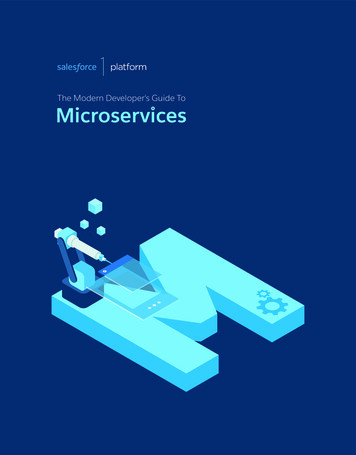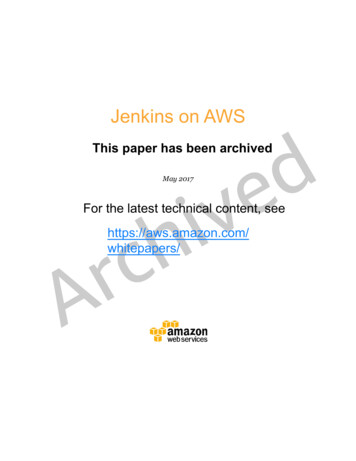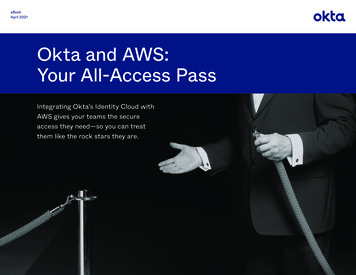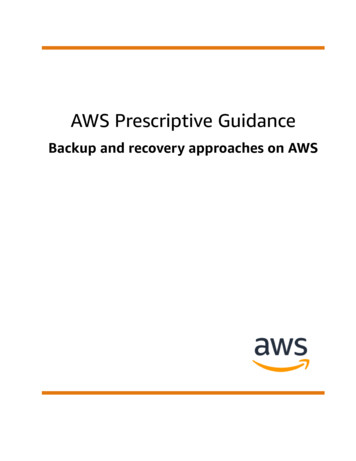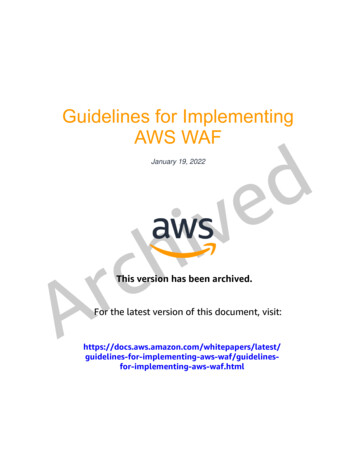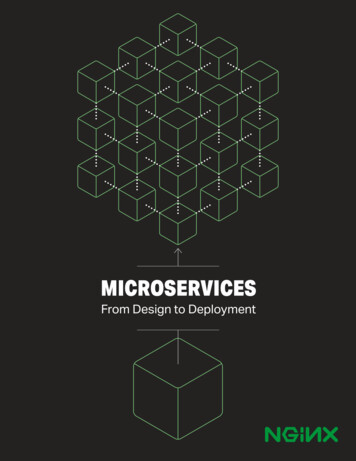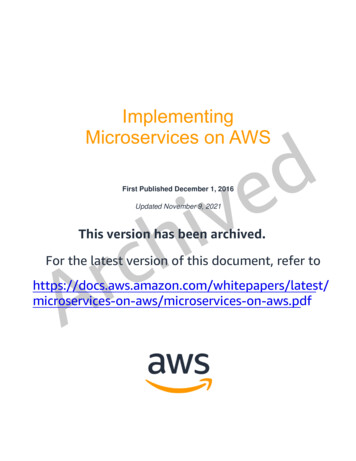
Transcription
ImplementingMicroservices on AWSdevihFirst Published December 1, 2016Updated November 9, 2021crAThis version has been archived.For the latest version of this document, refer icroservices-on-aws/microservices-on-aws.pdf
NoticesCustomers are responsible for making their own independent assessment of theinformation in this document. This document: (a) is for informational purposes only, (b)represents current AWS product offerings and practices, which are subject to changewithout notice, and (c) does not create any commitments or assurances from AWS andits affiliates, suppliers or licensors.AWS products or services are provided “as is” withoutwarranties, representations, or conditions of any kind, whether express or implied. Theresponsibilities and liabilities of AWS to its customers are controlled by AWSagreements, and this document is not part of, nor does it modify, any agreementbetween AWS and its customers.vihde 2021 Amazon Web Services, Inc. or its affiliates. All rights reserved.crA
ContentsIntroduction .5Microservices architecture on AWS .6User interface .6Microservices.7Data store .9deReducing operational complexity .10API implementation .11Serverless microservices .12vihDisaster recovery .14Deploying Lambda-based applications.15Distributed systems components .16crAService discovery .16Distributed data management.18Configuration management.21Asynchronous communication and lightweight messaging .21Distributed monitoring .26Chattiness.33Auditing .34Resources .37Conclusion .38Document Revisions.39Contributors .39
AbstractMicroservices are an architectural and organizational approach to softwaredevelopment created to speed up deployment cycles, foster innovation and ownership,improve maintainability and scalability of software applications, and scale organizationsdelivering software and services by using an agile approach that helps teams workindependently. With a microservices approach, software is composed of small servicesthat communicate over well-defined application programming interfaces (APIs) that canbe deployed independently. These services are owned by small autonomous teams.This agile approach is key to successfully scale your organization.deThree common patterns have been observed when AWS customers buildmicroservices: API driven, event driven, and data streaming. This whitepaper introducesall three approaches and summarizes the common characteristics of microservices,discusses the main challenges of building microservices, and describes how productteams can use Amazon Web Services (AWS) to overcome these challenges.vihDue to the rather involved nature of various topics discussed in this whitepaper,including data store, asynchronous communication, and service discovery, the reader isencouraged to consider specific requirements and use cases of their applications, inaddition to the provided guidance, prior to making architectural choices.crA
Amazon Web ServicesImplementing Microservices on AWSIntroductionMicroservices architectures are not a completely new approach to software engineering,but rather a combination of various successful and proven concepts such as: Agile software development Service-oriented architectures API-first design Continuous integration/continuous delivery (CI/CD)devihIn many cases, design patterns of the Twelve-Factor App are used formicroservices.This whitepaper first describes different aspects of a highly scalable, fault-tolerantmicroservices architecture (user interface, microservices implementation, and datastore) and how to build it on AWS using container technologies. It then recommendsthe AWS services for implementing a typical serverless microservices architecture toreduce operational complexity.crAServerless is defined as an operational model by the following tenets: No infrastructure to provision or manage Automatically scaling by unit of consumption Pay for value billing model Built-in availability and fault toleranceFinally, this whitepaper covers the overall system and discusses the cross-serviceaspects of a microservices architecture, such as distributed monitoring and auditing,data consistency, and asynchronous communication.This whitepaper only focuses on workloads running in the AWS Cloud. It doesn’tcover hybrid scenarios or migration strategies. For more information aboutmigration, refer to the Container Migration Methodology whitepaper.5
Amazon Web ServicesImplementing Microservices on AWSMicroservices architecture on AWSTypical monolithic applications are built using different layers—a user interface (UI)layer, a business layer, and a persistence layer. A central idea of a microservicesarchitecture is to split functionalities into cohesive verticals—not by technological layers,but by implementing a specific domain. The following figure depicts a referencearchitecture for a typical microservices application on AWS.devihcrATypical microservices application on AWSUser interfaceModern web applications often use JavaScript frameworks to implement a single-pageapplication that communicates with a representational state transfer (REST) or RESTful6
Amazon Web ServicesImplementing Microservices on AWSAPI. Static web content can be served using Amazon Simple Storage Service (AmazonS3) and Amazon CloudFront.Because clients of a microservice are served from the closest edge location and getresponses either from a cache or a proxy server with optimized connections to theorigin, latencies can be significantly reduced. However, microservices running close toeach other don’t benefit from a content delivery network. In some cases, this approachmight actually add additional latency. A best practice is to implement other cachingmechanisms to reduce chattiness and minimize latencies. For more information, refer tothe Chattiness topic.deMicroservicesAPIs are the front door of microservices, which means that APIs serve as the entry pointfor applications logic behind a set of programmatic interfaces, typically a RESTful webservices API. This API accepts and processes calls from clients, and might implementfunctionality such as traffic management, request filtering, routing, caching,authentication, and authorization.vihcrAMicroservices implementationAWS has integrated building blocks that support the development of microservices. Twopopular approaches are using AWS Lambda and Docker containers with AWS Fargate.With AWS Lambda, you upload your code and let Lambda take care of everythingrequired to run and scale the implementation to meet your actual demand curve withhigh availability. No administration of infrastructure is needed. Lambda supports severalprogramming languages and can be invoked from other AWS services or be calleddirectly from any web or mobile application. One of the biggest advantages of AWSLambda is that you can move quickly: you can focus on your business logic becausesecurity and scaling are managed by AWS. Lambda’s opinionated approach drives thescalable platform.A common approach to reduce operational efforts for deployment is container-baseddeployment. Container technologies, like Docker, have increased in popularity in the lastfew years due to benefits like portability, productivity, and efficiency. The learning curvewith containers can be steep and you have to think about security fixes for your Dockerimages and monitoring. Amazon Elastic Container Service (Amazon ECS) and Amazon7
Amazon Web ServicesImplementing Microservices on AWSElastic Kubernetes Service (Amazon EKS) eliminate the need to install, operate, andscale your own cluster management infrastructure. With API calls, you can launch andstop Docker-enabled applications, query the complete state of your cluster, and accessmany familiar features like security groups, Load Balancing, Amazon Elastic Block Store(Amazon EBS) volumes, and AWS Identity and Access Management (IAM) roles.AWS Fargate is a serverless compute engine for containers that works with bothAmazon ECS and Amazon EKS. With Fargate, you no longer have to worry aboutprovisioning enough compute resources for your container applications. Fargate canlaunch tens of thousands of containers and easily scale to run your most mission-criticalapplications.deAmazon ECS supports container placement strategies and constraints to customizehow Amazon ECS places and ends tasks. A task placement constraint is a rule that isconsidered during task placement. You can associate attributes, which are essentiallykey-value pairs, to your container instances and then use a constraint to place tasksbased on these attributes. For example, you can use constraints to place certainmicroservices based on instance type or instance capability, such as GPU-poweredinstances.vihcrAAmazon EKS runs up-to-date versions of the open-source Kubernetes software, so youcan use all the existing plugins and tooling from the Kubernetes community.Applications running on Amazon EKS are fully compatible with applications running onany standard Kubernetes environment, whether running in on-premises data centers orpublic clouds. Amazon EKS integrates IAM with Kubernetes, enabling you to registerIAM entities with the native authentication system in Kubernetes. There is no need tomanually set up credentials for authenticating with the Kubernetes control plane. TheIAM integration enables you to use IAM to directly authenticate with the control planeitself and provide fine granular access to the public endpoint of your Kubernetes controlplane.Docker images used in Amazon ECS and Amazon EKS can be stored in AmazonElastic Container Registry (Amazon ECR). Amazon ECR eliminates the need to operateand scale the infrastructure required to power your container registry.Continuous integration and continuous delivery (CI/CD) are best practices and a vitalpart of a DevOps initiative that enables rapid software changes while maintainingsystem stability and security. However, this is out of scope for this whitepaper. For more8
Amazon Web ServicesImplementing Microservices on AWSinformation, refer to the Practicing Continuous Integration and Continuous Delivery onAWS whitepaper.Private linksAWS PrivateLink is a highly available, scalable technology that enables you to privatelyconnect your virtual private cloud (VPC) to supported AWS services, services hosted byother AWS accounts (VPC endpoint services), and supported AWS Marketplace partnerservices. You do not require an internet gateway, network address translation device,public IP address, AWS Direct Connect connection, or VPN connection to communicatewith the service. Traffic between your VPC and the service does not leave the Amazonnetwork.dePrivate links are a great way to increase the isolation and security of microservicesarchitecture. A microservice, for example, could be deployed in a totally separate VPC,fronted by a load balancer, and exposed to other microservices through an AWSPrivateLink endpoint. With this setup, using AWS PrivateLink, the network traffic to andfrom the microservice never traverses the public internet. One use case for suchisolation includes regulatory compliance for services handling sensitive data such asPCI, HIPPA and EU/US Privacy Shield. Additionally, AWS PrivateLink allowsconnecting microservices across different accounts and Amazon VPCs, with no needfor firewall rules, path definitions, or route tables; simplifying network management.Utilizing PrivateLink, software as a service (SaaS) providers, and ISVs can offer theirmicroservices-based solutions with complete operational isolation and secure access,as well.crAvihData storeThe data store is used to persist data needed by the microservices. Popular stores forsession data are in-memory caches such as Memcached or Redis. AWS offers bothtechnologies as part of the managed Amazon ElastiCache service.Putting a cache between application servers and a database is a common mechanismfor reducing the read load on the database, which, in turn, may enable resources to beused to support more writes. Caches can also improve latency.Relational databases are still very popular to store structured data and businessobjects. AWS offers six database engines (Microsoft SQL Server, Oracle, MySQL,9
Amazon Web ServicesImplementing Microservices on AWSMariaDB, PostgreSQL, and Amazon Aurora) as managed services through AmazonRelational Database Service (Amazon RDS).Relational databases, however, are not designed for endless scale, which can make itdifficult and time intensive to apply techniques to support a high number of queries.NoSQL databases have been designed to favor scalability, performance, and availabilityover the consistency of relational databases. One important element of NoSQLdatabases is that they typically don’t enforce a strict schema. Data is distributed overpartitions that can be scaled horizontally and is retrieved using partition keys.deBecause individual microservices are designed to do one thing well, they typically havea simplified data model that might be well suited to NoSQL persistence. It is important tounderstand that NoSQL databases have different access patterns than relationaldatabases. For example, it is not possible to join tables. If this is necessary, the logichas to be implemented in the application. You can use Amazon DynamoDB to create adatabase table that can store and retrieve any amount of data and serve any level ofrequest traffic. DynamoDB delivers single-digit millisecond performance, however, thereare certain use cases that require response times in microseconds. AmazonDynamoDB Accelerator (DAX) provides caching capabilities for accessing data.vihcrADynamoDB also offers an automatic scaling feature to dynamically adjust throughputcapacity in response to actual traffic. However, there are cases where capacity planningis difficult or not possible because of large activity spikes of short duration in yourapplication. For such situations, DynamoDBprovides an on-demand option, which offerssimple pay-per-request pricing.DynamoDB on-demand is capable of serving thousandsof requests per second instantly without capacity planning.Reducing operational complexityThe architecture previously described in this whitepaper is already using managedservices, but Amazon Elastic Compute Cloud (Amazon EC2) instances still need to bemanaged. The operational efforts needed to run, maintain, and monitor microservicescan be further reduced by using a fully serverless architecture.10
Amazon Web ServicesImplementing Microservices on AWSAPI implementationArchitecting, deploying, monitoring, continuously improving, and maintaining an API canbe a time-consuming task. Sometimes different versions of APIs need to be run toassure backward compatibility for all clients. The different stages of the developmentcycle (for example, development, testing, and production) further multiply operationalefforts.Authorization is a critical feature for all APIs, but it is usually complex to build andinvolves repetitive work. When an API is published and becomes successful, the nextchallenge is to manage, monitor, and monetize the ecosystem of third-party developersutilizing the APIs.deOther important features and challenges include throttling requests to protectthebackend services, caching API responses, handling request and responsetransformation, and generating API definitions and documentation with tools such asSwagger.vihAmazon API Gateway addresses those challenges and reduces the operationalcomplexity of creating and maintaining RESTful APIs. API Gateway allows you to createyour APIs programmatically by importing Swagger definitions, using either the AWS APIor the AWS Management Console. API Gateway serves as a front door to any webapplication running on Amazon EC2, Amazon ECS, AWS Lambda, or in any onpremises environment. Basically, API Gateway allows you to run APIs without having tomanage servers.crAThe following figure illustrates how API Gateway handles API calls and interacts withother components. Requests from mobile devices, websites, or other backend servicesare routed to the closest CloudFront Point of Presence to minimize latency and provideoptimum user experience.11
Amazon Web ServicesImplementing Microservices on AWSdevihAPI Gateway call flowcrAServerless microservices“No server is easier to manage than no server.” — AWS re:InventGetting rid of servers is a great way to eliminate operational complexity.Lambda is tightly integrated with API Gateway. The ability to make synchronous callsfrom API Gateway to Lambda enables the creation of fully serverless applications and isdescribed in detail in the Amazon API Gateway Developer Guide.The following figure shows the architecture of a serverless microservice with AWSLambda where the complete service is built out of managed services, which eliminatesthe architectural burden to design for scale and high availability, and eliminates theoperational efforts of running and monitoring the microservice’s underlyinginfrastructure.12
Amazon Web ServicesImplementing Microservices on AWSdecrAvihServerless microservice using AWS LambdaA similar implementation that is also based on serverless services is shown in thefollowing figure. In this architecture, Docker containers are used with Fargate, so it’s notnecessary to care about the underlying infrastructure. In addition to DynamoDB,Amazon Aurora Serverless is used, which is an on-demand, auto-scaling configurationfor Aurora (MySQL-compatible edition), where the database will automatically start up,shut down, and scale capacity up or down based on your application's needs.13
Amazon Web ServicesImplementing Microservices on AWScrAvihServerless microservice using FargateDisaster recoverydeAs previously mentioned in the introduction of this whitepaper, typical microservicesapplications are implemented using the Twelve-Factor Application patterns. TheProcesses section states that “Twelve-factor processes are stateless and sharenothing. Any data that needs to persist must be stored in a stateful backing service,typically a database.”For a typical microservices architecture, this means that the main focus for disasterrecovery should be on the downstream services that maintain the state of theapplication. For example, these can be file systems, databases, or queues, for example.When creating a disaster recovery strategy, organizations most commonly plan for therecovery time objective and recovery point objective.Recovery time objective is the maximum acceptable delay between the interruption ofservice and restoration of service. This objective determines what is considered anacceptable time window when service is unavailable and is defined by the organization.14
Amazon Web ServicesImplementing Microservices on AWSRecovery point objective is the maximum acceptable amount of time since the lastdata recovery point. This objective determines what is considered an acceptable loss ofdata between the last recovery point and the interruption of service and is defined bythe organization.For more information, refer to the Disaster Recovery of Workloads on AWS: Recoveryin the Cloud whitepaper.High availabilitydeThis section takes a closer look at high availability for different compute options.Amazon EKS runs Kubernetes control and data plane instances across multipleAvailability Zones to ensure high availability. Amazon EKS automatically detects andreplaces unhealthy control plane instances, and it provides automated version upgradesand patching for them. This control plane consists of at least two API server nodes andthree etcd nodes that run across three Availability Zones within a region. Amazon EKSuses the architecture of AWS Regions to maintain high availability.vihAmazon ECR hosts images in a highly available and high-performance architecture,enabling you to reliably deploy images for container applications across AvailabilityZones. Amazon ECR works with Amazon EKS, Amazon ECS, and AWS Lambda,simplifying development to production workflow.crAAmazon ECS is a regional service that simplifies running containers in a highly availablemanner across multiple Availability Zones within an AWS Region. Amazon ECSincludes multiple scheduling strategies that place containers across your clusters basedon your resource needs (for example, CPU or RAM) and availability requirements.AWS Lambda runs your function in multiple Availability Zones to ensure that it isavailable to process events in case of a service interruption in a single zone. If youconfigure your function to connect to a virtual private cloud (VPC) in your account,specify subnets in multiple Availability Zones to ensure high availability.Deploying Lambda-based applicationsYou can use AWS CloudFormation to define, deploy, and configure serverlessapplications.15
Amazon Web ServicesImplementing Microservices on AWSThe AWS Serverless Application Model (AWS SAM) is a convenient way to defineserverless applications. AWS SAM is natively supported by CloudFormation and definesa simplified syntax for expressing serverless resources. To deploy your application,specify the resources you need as part of your application, along with their associatedpermissions policies in a CloudFormation template, package your deployment artifacts,and deploy the template. Based on AWS SAM, SAM Local is an AWS Command LineInterface tool that provides an environment for you to develop, test, and analyze yourserverless applications locally before uploading them to the Lambda runtime. You canuse SAM Local to create a local testing environment that simulates the AWS runtimeenvironment.deDistributed systems componentsvihAfter looking at how AWS can solve challenges related to individual microservices, thefocus moves to on cross-service challenges, such asservice discovery, dataconsistency, asynchronous communication, and distributed monitoring and auditing.Service discoverycrAOne of the primary challenges with microservice architectures is enabling services todiscover and interact with each other. The distributed characteristics of microservicearchitectures not only make it harder for services to communicate, but also presentsother challenges, such as checking the health of those systems and announcing whennew applications become available. You also must decide how and where to store metainformation, such as configuration data, that can be used by applications. In this sectionseveral techniques for performing service discovery on AWS for microservices-basedarchitectures are explored.DNS-based service discoveryAmazon ECS now includes integrated service discovery that enables your containerizedservices to discover and connect with each other.Previously, to ensure that services were able to discover and connect with each other,you had to configure and run your own service discovery system based on AmazonRoute 53, AWS Lambda, and ECS event streams, or connect every service to a loadbalancer.16
Amazon Web ServicesImplementing Microservices on AWSAmazon ECS creates and manages a registry of service names using the Route 53Auto Naming API. Names are automatically mapped to a set of DNS records so that youcan refer to a service by name in your code and write DNS queries to have the nameresolve to the service’s endpoint at runtime. You can specify health check conditions ina service's task definition and Amazon ECS ensures that only healthy service endpointsare returned by a service lookup.In addition, you can also use unified service discovery for services managed byKubernetes. To enable this integration, AWS contributed to the External DNS project, aKubernetes incubator project.deAnother option is to use the capabilities of AWS Cloud Map. AWS Cloud Map extendsthe capabilities of the Auto Naming APIs by providing a service registry for resources,such as Internet Protocols (IPs), Uniform Resource Locators (URLs), and AmazonResource Names (ARNs), and offering an API-based service discovery mechanism witha faster change propagation and the ability to use attributes to narrow down the set ofdiscovered resources. Existing Route 53 Auto Naming resources are upgradedautomatically to AWS Cloud Map.vihcrAThird-party softwareA different approach to implementing service discovery is using third-partysoftware suchas HashiCorp Consul, etcd, or Netflix Eureka. All three examples are distributed, reliablekey-value stores. For HashiCorp Consul, there is an AWS Quick Start that sets up aflexible, scalable AWS Cloud environment and launches HashiCorp Consulautomatically into a configuration of your choice.Service meshesIn an advanced microservices architecture, the actual application can be composed ofhundreds, or even thousands, of services. Often the most complex part of theapplication is not the actual services themselves, but the communication between thoseservices. Service meshes are an additional layer for handling interservicecommunication, which is responsible for monitoring and controlling traffic inmicroservices architectures. This enables tasks, like service discovery, to be completelyhandled by this layer.Typically, a service mesh is split into a data plane and a control plane. The data planeconsists of a set of intelligent proxies that are deployed with the application code as a17
Amazon Web ServicesImplementing Microservices on AWSspecial sidecar proxy that intercepts all network communication between microservices.The control plane is responsible forcommunicating with the proxies.Service meshes are transparent, which means that application developers don’t have tobe aware of this additional layer and don’t have to make changes to existing applicationcode. AWS App Mesh is a service mesh that provides application-level networking toenable your services to communicate with each other across multiple types of computeinfrastructure. App Mesh standardizes how your services communicate, giving youcomplete visibility and ensuring high availability for your applications.deYou can use App Mesh with existing or new microservices running on Amazon EC2,Fargate, Amazon ECS, Amazon EKS, and self-managed Kubernetes on AWS. AppMesh can monitor and control communications for microservices running acrossclusters, orchestration systems, or VPCs as a single application without any codechanges.vihDistributed data managementMonolithic applications are typically backed by a large relational database, whichdefines a single data model common to all application components. In a microservicesapproach, such a central database would prevent the goal of building decentralized andindependent components. Each microservice component should have its own datapersistence layer.crADistributed data management, however, raises new challenges. As a consequence ofthe CAP theorem, distributed microservice architectures inherently trade off consistencyfor performance and need to embrace eventual consistency.In a distributed system, business transactions can span multiple microservices.Because they cannot use a single ACID transaction, you can end up with partialexecutions. In this case, we would need some control logic to redo the alreadyprocessed transactions. For this purpose, the distributed Saga pattern is commonlyused. In the case of a failed business transaction, Saga orchestrates a series ofcompensating transactions that undo the changes that were made by the precedingtransactions. AWS Step Functions make it easy to implement a Saga executioncoordinator as shown in the following figure.18
Amazon Web ServicesImplementing Microservices on AWSdeSaga execution coordinatorBuilding a centralized store of critical reference data that is curated by core datamanagement tools and procedures provides a means for microservices t
microservices: API driven, event driven, and data streaming. This whitepaper introduces all three approaches and summarizes the common characteristics of microservices, discusses the main challenges of building microservices, and describes how product teams can use Amazon Web Services (AWS) to overcome these challenges.File Size: 1MB
